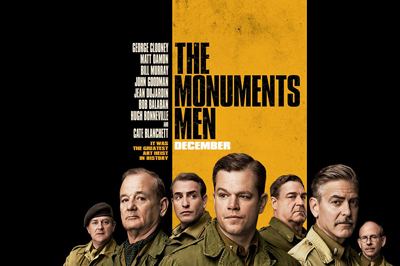
Under the guidance of ‘art collectors' Adolf Hitler and Hermann Goering, the Nazis were responsible for the biggest and best organized art looting the world has ever seen, and probably will ever see. Special military Kunstschutz units ‘collected’ art from across Europe in truly epic fashion, utilizing an entire infrastructure of warehouses, trains, transit facilities to process the stolen items. The Allies eventually invaded Europe and put a stop to the fun, which is where a small US army unit known as The Monuments Men 'came into the picture’ so to speak.
The Monuments Men were charged with saving as many European cultural treasures as was possible, given the extremely liberal use of high explosives and artillery by both sides in the conflict. When the Monuments Men actually arrived in Europe, they found not only that it’s hard to keep soldiers from blowing stuff up, but that the Nazi looted art had been on the move. It was kept in a variety of likely and unlikely hiding places. Tracking down the looted art then became their next mission, and with little to no resources they did a heroic job
Their efforts have been chronicled in a number of great books, including Rescuing Da Vinci and The Monuments Men both by Robert Edsel, and The Rape of Europa by Lynn Nicholas. In addition, the Rape of Europe was turned into a widely acclaimed 2006 documentary movie called ‘The Rape of Europa.
Now George Clooney has directed ‘The Monuments Men’ which comes out February 2014. The trailer looks terrific, and AP has a great interview on it with Clooney. It stars James Bond (Daniel Craig), John Goodman, Bill Murray, Lord Grantham (Hugh Bonneville), the French George Clooney (Jean Dujardin), the American George Clooney (George Clooney), the Queen/Lady Galadriel (Cate Blanchett), and of course Matt Damon.
Places where the monuments men recovered stolen art included
1) An Art Train in Paris. As the allied army approached Paris, the Nazis frantically packed what they thought would be their last train full of looted art and sent it off to Germany. However, the French resistance had a spy, Rose Valland, inside the German art looting bureaucracy and she tipped them off. Together they managed to slow down the departure long enough so that the train never got beyond a rail yard in the Parisian suburbs. The 1965 movie The Train starring Burt Lancaster tells the story.
2) An Art train in Germany. Hermann Goering’s personal train came under attack and was derailed. A rumor spread among local villagers that the train was carrying booze, so they looted the train. They may or may not have found booze, we don’t know, but in their search for liquor, they tossed the artworks aside and left priceless paintings lying out in the snow. Fun fact: the train had an oversize pink marble bathtub to accommodate Goering’s plus size figure. Since he hated water sloshing around in his tub, the train had to stop while he bathed. This often brought large portions of the German rail system to a standstill until he was finished.
3) An Art Cave in Austria. The Nazis used lots of mines to store looted art. One of the largest was a salt mine at Altaussee in Austria. Towards the end of the war, the local Nazi leader planned to blow it up to prevent the art in it from falling into Allied hands, but the miners, fearing that they would lose their jobs if the mine was destroyed, removed the heavy explosives and replaced them with less powerful ones. The blasts only sealed the mine, rather than destroying it, and the art, including the Madonna of Bruges, by Michelangelo, and The Astronomer by Vermeer, was saved.
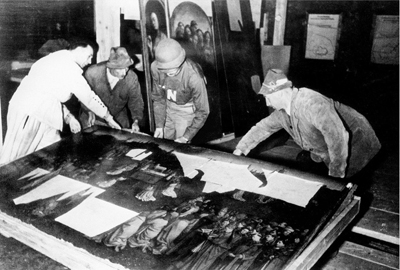
Recovering the center panel of the Ghent Altarpiece by Jan van Eyck from a salt mine in Altaussee, Austria. The Monuments man with the N on his jacket is George Stout.
4) An Art Cave in Germany.
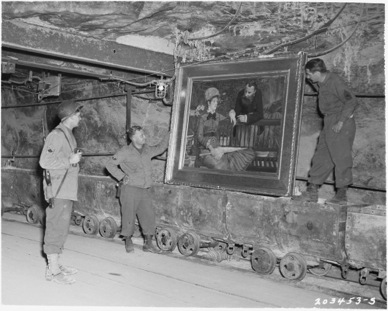
Retrieving ‘In the Conservatory’ by Edouard Manet from a mine near Merkers, Germany
5) Another Art Cave in Germany.
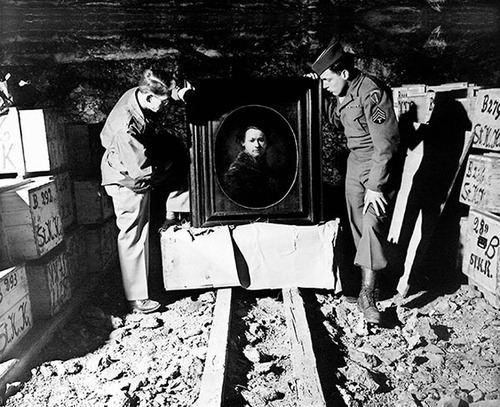
Privates Karl Ettlinger and Harry Ford at the Heilbronn mine in Southern Germany with a Rembrandt self-portrait. Ettlinger was a Jew whose family had fled from Germany to the US.
5) The House of Governor General of Poland, and mass murderer, Hans Frank. Rembrandt’s Landscape with the Good Samaritan and Da Vinci’s Lady with an Ermine were among the paintings the monuments men recovered from his residence.
6) The Berlin Untergrundbahn (Underground). When the Russians got to Berlin they found a treasure trove of looted art in the city’s subway. The Russians took most of it back to Russia to save it from the poor conditions underground. To this date, much of this art remains in Russia. Some eyewitnesses have said that the poor conditions were a fiction and that the Germans in fact had humidity and temperature controlled storage facilities far superior to anything available in Russia (no offense, Russia).
7) Neuschwanstein Castle. A facility straight out of Chitty Chitty Bang Bang, where almost every room was chock a block with crates of looted art.
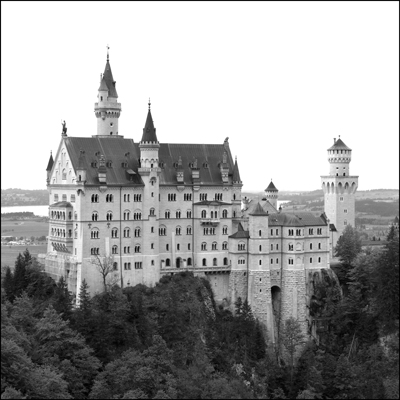
The castle
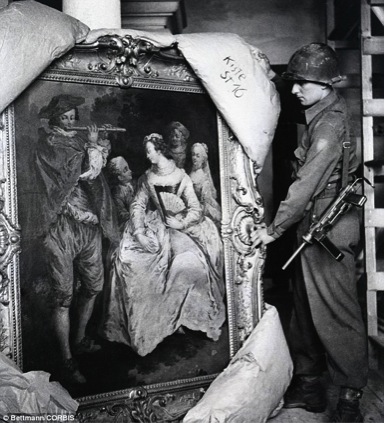
The contents
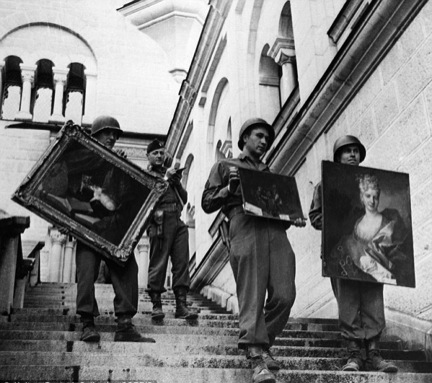
Monuments man James Rorimer and three privates









